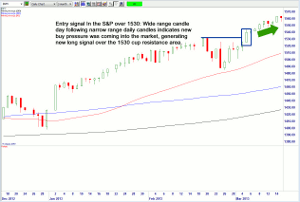Welles Wilder is a name well-known to technical analysts for creating a host of indicators such as the RSI, DMI, and others, and Ken Calhoun of TradeMastery.com and DaytradingUniversity.com discusses another one of Wilder's indicators for generating entry and exit signals.
In this second article, we'll look at how to combine wide-range candles as shown in the prior article with a new strategy-that of using Wilder's ADX (average directional index), for momentum stock entry signals. As markets start to show signs of fatigue following a strong rally, it's especially important to be on the lookout for both continuation, as well as exhaustion signals in the charts, to start scaling out of open swing trades, as well as initiate new positions if markets continue upwards.
Using Wide-Range Candles With the S&P: How It Worked During This Rally
In our first article, we looked at how to use "wide range" candles; specifically the pattern as shown in Figure 1 (S&P 500 Index) in which a wide-range candle day was seen after a series of narrow candles. This generated a "buy the markets" signal once it broke over 1530 resistance. It's important when using this technique to make sure to wait for new highs to be taken out above the wide-range candle day prior to entering, to avoid a false breakout.
When used with indexes, it's wise to use a 10-point "false breakout" filter, in this case that would be to wait for highs above 1540 before entering. For stocks and ETFs, it's good to use a .35-cent false breakout filter (for example if the prior day's wide-range candle had a high of $44.0 even, the long breakout signal would be at $44.35).
Once in a trade, in addition to standard reversal candle patterns to watch for (such as shooting stars and bearish engulfing patterns), it's also important to watch for narrow-range candles following a rally. We currently see this in the S&P Figure 1 chart, by the way, as the most recent candles have narrow candle bodies, indicating less strength, and that the markets may pull back or sell down soon (in this case, we'd close open long trades in stocks/ETFs once the S&P loses 1550 support, which may well occur soon).
Also looking back at the Figure 1 chart, you can see the wide-range candle back in early January, on which then was followed by a multi-week long rally. Spotting these alternating wide-vs.-narrow daily candle patterns can be of tremendous value in helping astute active swing and day traders spot upcoming volatility for momentum stock entry signals as they're happening in the markets.
NEXT PAGE: Using ADX for Entries and Exits
|pagebreak|Using Wilders' ADX (Average Directional Index) for Swing Trading Entries
The ADX indicator does an effective job of helping traders spot increasing vs. decreasing trend strength and volatility. While often used in conjunction with the blue and green DMI (directional movement) indicator lines, it can be used by itself, as shown in Figure 2, Wells Fargo & Co. (WFC) to generate trading signals.
The primary value of the ADX is to show increasing vs. decreasing volatility and trend strength. During strong trends (and/or gap continuations), the red ADX signal line will increase. During times of consolidation, the ADX will decrease. What's important about the ADX, compared to other indicators, is that because volatility often leads to new volatility and breakout continuations, it can be used as a rare leading indicator.
How it works, is that one looks for the red ADX line to break above 40 to indicate a new breakout is likely to occur during the day or two following this breakout signal. For example, on Feb. 28, the red ADX line broke above 40, signaling that a new long breakout in the WFC stock price was likely. As usual, we set a long trigger .35 cents above the high of the day in which the red ADX > 40 signal was generated. So, a new breakout on the days following that signal was effective.
Similarly, a second signal in WFC was generated when the red ADX line, after dropping for several days, again broke out above 40, indicating a new long signal, in this case several days later on March 15, as it took out new highs following a gap.
This process is relatively simple and easy to follow; just look for a red ADX line to come from below the 40 to break out over 40, then set a buy-stop order for .35 above the high of the day in which the signal was generated, for a maximum of 4-5 days following the signal. To exit trades, one can use a stop-loss of no more than 1.5 points under the day's low of the day the trade was entered. Keep an eye on the red ADX, if it starts to decline, that means price action is likely consolidating, so a trailing stop can be tightened in at this point as well.
Looking at exiting trades, as well as entering new positions, can be effective once active traders learn to look for these and other momentum trading signals, for managing trading decisions. In our next article we'll look at additional momentum trading signals that can be used for swing and intraday trades.
Ken Calhoun is a trading professional who has traded millions of dollars of equities since the 1990s, and is the producer of multiple award-winning trading courses and video-based training systems for active traders. He is a UCLA alumnus and is the founder of TradeMastery.com and DaytradingUniversity.com, popular online educational sites that reach tens of thousands of active traders worldwide.




















